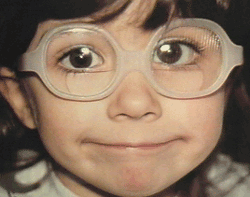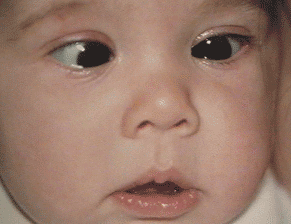Alaska Blind Child Discovery
A
cooperative, charitable research project to vision screen every preschool
Alaskan
Esotropia
Home
Detection: Parents and pediatricians often are first to notice crossing in a new-born or infant. The eyes may stay crossed, they may occasionally cross or the child may look with one eye while always crossing the other. When an eye turns in, it may look out poorly and it may show minimal white on the inside toward the nose. False crossed appearance (Pseudostrabismus) can occur when an infant's nasal skin fold covers the inside white of an otherwise straight eye. When a straight eye looks at a light, a reflection centers in the pupil and a dark red reflex is present as can been seen in some flash photographs. True crossing can be detected by abnormal light reflections and abnormal red reflexes (Bruckner's Reflex).
Sequelae: Under normal conditions, we have very poor vision at birth (20/2000) in each eye and gradually develop good vision in each eye which remains permanent after age ten years. Depth perception from binocular vision is first measured by age 4 months and improves up to age ten years. If an eye has vision blocked (i.e. from juvenile cataract), or if the eye is poorly focused (i.e. from too much astigmatism or unequal farsightedness) or if the eyes remain misaligned (strabismus), then the brain will fail to learn good vision and wil have absent or subnormal depth perception (Amblyopia). Pediatric ophthalmologists strive to prevent all forms of amblyopia but cannot do so without much help from parents.
Accommodative Convergence The brain normally controls three eye functions at once; close focus (accomodation), turning each eye in to align on a near object (convergence) and pupil constriction. It is impossible to separate these normal brain functions. When we focus close, our eye should turn in. As a result of normal alignment of each eye, images are correctly projected to the brain resulting in normal visual development of each eye and the development of binocular vision and depth perception over the first ten years of life. Improper alignment of the eyes (strabismus) can result in poor development of the vision in the less preferred eye (amblyopia) and absent depth perception.
Near sighted people can easily focus on close objects but require glasses to see distance. When near sighted people use the focus muscles in their eyes, they focus even closer-up to the tip of the nose! Far sighted people are un-focused at distance and more so at near when they do not use the focus muscles in their eyes. In order to focus on a distant object they must use some eye focus power (accommodation). Far sighted people must use lots of focus muscle power to see near objects.
It is common for far-sighted children between the age of 18 months and 3 years to start crossing their eyes especially for near objects and when tired. This is because children start wanting to focus on details after age one, and the extra focus power required by the far-sighted child is connected in their normal brains with turning the eyes in. Usually, prescription of the correct far-sighted glasses (after dilated exam) will result in straight eyes for these children.
Accomodative with increased AC/A: While it is normal for our eyes to turn in a certain amount for a given amount of close focusing, some children demonstrate an exaggerated amount of crossing for a given amount of close focusing. This tendency resides in their brain. Bifocal glasses and an eye drop called phospholine iodide (PI) can help such patients. The PI drops and the bifocals make close focusing easier and therefore reduces the crossing tendency which is controled by that child's brain. PI can cause little bumps in the pupil but the main complication of PI drops is the potential to prolong muscle relaxants during general anesthesia since the drop gets gradually absorbed into the body as well as the eyes. If your child is on PI drops, remember to notify your anesthesiologist in the event of surgery.
Vergence amplitudes (Jumping over a stick- analogy) Although most people appear to have straight eyes, most actually are compensating for small amounts of mis-alignment (phorias). The ability to make adjustments of phorias is called a vergence amplitude. A vergence amplitude might be likened to being able to jump over a stick. Most of us can jump over a stick 10 inches off the ground or perhaps 15 inches but rarely can we jump 25 inches. The same for a persons ability to make adjustments for amounts of misalignment of the eyes measured in prism diopters. Two prism diopters is about the same as one degree. Most people can only adjust for 15 or less prism diopters of crossing and the more adjustment requires more effort. Some older people are plagued by doublevision because they lose their vergence amplitudes.
Tendency to stay straight (analogous to marriage for Billy Graham's wife Ruth and Elizabeth Taylor) We are born with tendencies to keep our eyes aligned. Some of us are born with very poor abilities to keep our eyes aligned (drift-tendency) which often results in early crossing of the eyes (essential infantile esotropia). Others may have had a mechanical reason for early crossing greater than their ability to compensate for it. Crossed eyes can almost always be straightened by glasses or surgery. Over time, some straightened eyes stay straight while others drift away from straight. Eye doctors are unable to know whether a cross-eyed child is a drifter or one who will stay straight until attempts have been made for the first few years to help the eye be straight. For those with a drifting tendency, good vision can usually be attained in each eye but even as an adult the eyes may continue to drift out, in or vertically. The tendency to keep our eyes straight might be likened to the future tendency of a maiden to stay married for life. The future Ruth Graham had a strong tendency to stay married while the future Elizabeth Taylor did not. We often don't know a given child's tendency to stay straight for several year, or in the case of Elizabeth Taylor, several attempts at marriage. Some children require several surgical procedures to keep their eyes reasonably straight.
Essential Infantile Esotropia (EIE): This is a common form of crossing which is also known as congenital esotropia. Not every child with this condition is born crossed, however. Most patients with EIE cross before age 6-12 months and do not have very much far-sightedness. Vertical misalignment can accompany EIE. In addition to crossing, An EIE patient may demonstrate more crossing up (A-pattern), more crossing down (V-pattern), overaction of the oblique muscles or up-drift tendency of each eye (DVD). Surgery is almost alway required to allow straight eyes and prevention of amblyopia in an EIE patient.
Mixed Mechanism: Several children are eventually found to have crossing partly treatable by glasses and partly requiring surgical treatment resembly EIE.
Duane's Syndrome/ 6th Nerve Palsy: The sixth nerve from the brain stem controls the muscle which pulls our eyes out. A weak sixth nerve can be a cause of an in-turning eye. If the sixth nerve weakness occurs before birth, that eye may not turn completly out. During development, some of the nerve from the in-turning muscle may attach to the out-turning muscle. In this condition (Duane's Syndrome) the eye doesn't turn completely out and the eye lids narrow when the eye turns in. Surgery is occasionally required to help the child look straight ahead.
Sensory strabismus: We keep our eyes straight by superimposing the images from each eye to avoid double vision. If one of our eyes sees very poorly, then that eye may drift out of alignment. Poor vision in a child's eye can be caused by poor development of the optic nerve or retina, potentially fatal retinal tumors, cataracts or infections. It is critical to fully examine any child whose eyes are not aligned.
Esophoria/ Intermittent Esotropia: Occasionally, some children have eyes that gradually drift in when the child is tired or day-dreaming. This may start at any age. Such crossing is compensated well when the child is alert enough to exert the muscle energy to pull the eyes back straight. Surgery or glasses are required only when the child has enough difficulty compensating for the drift.
Prevalence: Esotropia is the most common form of strabismus constituting 1/2 to 2/3 of all misaligned eyes. About 5% of people have strabismus. The more common types have bolder boxes in the figure below.
ABCD History
Kids Eye Disorders
Amblyopia
Vision Screening
Issues
ABCD Clinics
References
Contact ABCD


Essential
Infantile ("Congenital") Esotropia:


